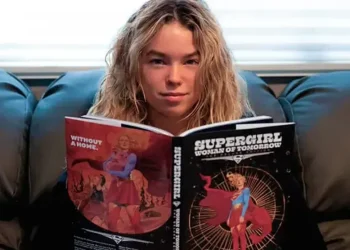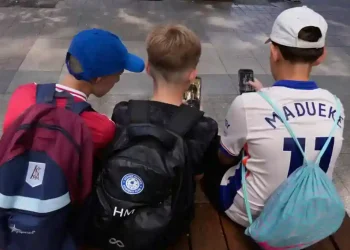Justin Baldoni Sues The New York Times for $250 Million Over Blake Lively’s Allegations
Justin Baldoni has taken legal action, filing a $250 million libel lawsuit against The New York Times in response to an article that detailed accusations of sexual harassment by his co-star, Blake Lively. The suit claims that the newspaper published a story “rife with inaccuracies, misrepresentations, and omissions” by relying heavily on Lively’s “self-serving narrative.”
The Allegations and Legal Battle
In December, Lively filed a complaint with the California Civil Rights Department, accusing Baldoni of sexual harassment and retaliation. Lively claimed that after voicing concerns about harassment on the set of their film It Ends With Us, Baldoni and his team retaliated by leaking negative press to damage her professional reputation. The New York Times reported on these allegations in an article titled “‘We Can Bury Anyone’: Inside a Hollywood Smear Machine” on December 21, which included details from Lively’s complaint—information that is typically confidential.
Following the publication of the article and Lively’s claims, Baldoni was dropped by his talent agency, WME, which also represents Lively and her husband, Ryan Reynolds. The Screen Actors Guild (SAG-AFTRA) quickly showed support for Lively, and Sony, the studio behind It Ends With Us, also backed her.
Baldoni’s Lawsuit: False Allegations and Strategic Manipulation
In his lawsuit, Baldoni argues that Lively fabricated the allegations of sexual harassment in order to take control of the film production and reshape her public image. He accuses her of using “salacious, headline-grabbing allegations” to damage his reputation and distract from her own public blunders.
The lawsuit also claims that The New York Times failed to uphold journalistic standards, publishing the article based largely on unverified claims from Lively while disregarding evidence that contradicted her narrative. Baldoni’s legal team asserts that the newspaper “lifted nearly verbatim” from Lively’s account without fact-checking and ignored critical evidence that exposed her motives.
A spokesperson for The New York Times responded, defending the article’s accuracy, saying it was “meticulously and responsibly reported” based on thousands of pages of documents, including text messages and emails. The spokesperson emphasized that no errors had been pointed out by Baldoni or his representatives.
Lively’s Counterclaim: A New Federal Lawsuit
Despite Baldoni’s legal actions, Lively’s attorneys maintain that her allegations remain unchanged. They filed a federal complaint on Tuesday, addressing the same claims made in her original complaint to the California Civil Rights Department. Lively’s legal team is eager to defend her position in court.
Meanwhile, Baldoni’s lawsuit was filed by attorney Bryan Freedman in Los Angeles Superior Court, representing a total of 10 plaintiffs, including Baldoni, Wayfarer Studios, and his producing partner, Jamey Heath—who is also accused of sexual harassment by Lively. The suit also includes Baldoni’s publicist and crisis manager, Jennifer Abel and Melissa Nathan.
Disputed Text Messages and Further Accusations
Central to the legal dispute are text messages between Baldoni and Lively. Lively’s complaint included text messages that allegedly demonstrated an orchestrated attempt by Baldoni’s PR team to damage her reputation. However, Baldoni’s suit contends that these messages were manipulated, claiming the Times intentionally omitted messages that contradicted Lively’s version of events.
Baldoni’s legal team has provided what they believe are irrefutable text messages showing Lively’s own involvement in creating a smear campaign. One example includes a text from Lively to Baldoni stating that she was “just pumping in my trailer if you wanna work out our lines,” which directly contradicts a claim made in her complaint that Baldoni and Heath entered her trailer uninvited while she was undressed, including while breastfeeding.
The Snowball Effect: Legal and Media Fallout
Since the initial complaint, both parties have been embroiled in a back-and-forth exchange, raising questions about how private messages were obtained. Baldoni’s former publicist, Stephanie Jones, filed a lawsuit claiming that the text messages came from the phone of Baldoni’s current publicist, Abel. Abel and others named in Lively’s complaint have denied all of the allegations, asserting that it was Lively who leaked negative press to damage Baldoni’s image.
In a statement to CNN, Baldoni’s attorney, Bryan Freedman, described the situation as a “vicious smear campaign” against Baldoni. Freedman accuses Lively and The New York Times of manipulating the narrative to revitalize Lively’s public image in the face of mounting criticism.
“We embrace the full truth,” Freedman said, “and we have all of the communications to back it.”
Looking Ahead
As both parties prepare for legal battles in court, the case has sparked further questions about the manipulation of media narratives in the age of social media and celebrity influence. Lively’s allegations have garnered widespread attention, but Baldoni’s lawsuit claims that much of the public perception is based on misinformation and a skewed narrative.
The lawsuit, which calls for substantial damages, is likely to continue to make headlines as both sides present their arguments in court. As the legal process unfolds, both Baldoni and Lively’s teams are committed to defending their positions, with each party asserting that the truth is on their side.
This article was rewritten by JournosNews.com based on verified reporting from trusted sources. The content has been independently reviewed, fact-checked, and edited for accuracy, neutrality, tone, and global readability in accordance with Google News and AdSense standards.
All opinions, quotes, or statements from contributors, experts, or sourced organizations do not necessarily reflect the views of JournosNews.com. JournosNews.com maintains full editorial independence from any external funders, sponsors, or organizations.
Stay informed with JournosNews.com — your trusted source for verified global reporting and in-depth analysis. Follow us on Google News, BlueSky, and X for real-time updates.














